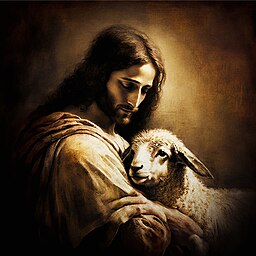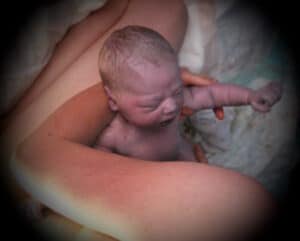This main image is from artist Jessie Payne (Terra & Sage on Instagram), and is titled “I Know My Sheep”.
Our guest author is a non-binary Latter-day Saint. They currently live in Utah pursuing a bachelor’s degree in psychology. You can find them on Instagram at @androgynous_saint.
Non-Binary is an identity under the transgender umbrella that indicates a gender that is not exclusively male or female, and July 14th is International Non-Binary People’s Day!
I wanted to make a celebratory post in honor of Non-Binary People’s Day. People tend to feel more comfortable when I share happy things about my gender identity, not upsetting things. But I realized that since women are taking the brave step to point out institutional issues that affect them, I can do the same. Latter-day Saint women have courageously spoken up about modesty, garments, Heavenly Mother, polygamy, pressure to conform to social roles, lack of inclusion, and not being granted the privilege to hold priesthood offices. It may make some men uncomfortable to read about these things, but that doesn’t mean they shouldn’t read them. Likewise, some of the issues I will address may cause some discomfort, but people still need to learn about them. Just as there are many well-meaning men that can’t know about LDS women’s issues unless they are told them, well-intentioned members can’t see the institutional barriers I deal with unless I speak up about them.
So much of our church culture and practice is gendered. Let’s begin with the typical pulpit greeting, “Good morning/afternoon, brothers and sisters”. I love that we address one another with familial terms to emphasize that as all of us are God’s children, we are spiritual family. But “brothers and sisters” isn’t all encompassing when non-binary people exist. I feel a bit left out of the family, so to speak. Perhaps I’m being hypercritical here. Then again, small gestures can make a big impact. So next time you give a talk in sacrament meeting, try opening with a simple “Good morning, everyone”. Or if you’re feeling bold, address the congregation as “siblings in Christ”. The word “sibling” doesn’t have an emotionally warm connotation. But maybe it would someday if people started using it.
Another issue is bathrooms. The outrageous political uproar over trans people in public restrooms is horrifying. The sad reality is, many trans people have had to just get used to being cautious and nervous when using public bathrooms. But like the nursing mother who wakes up from being accustomed to an inadequate mother’s lounge, I’ve come to realize that it really isn’t fair that I am stressed when using the bathroom; especially if it’s at a church where I’m supposed to feel safe and welcome. Some trans people are able to pass well enough as one gender or another and are able to get by. But if I were to fully express my gender in a way that affirms me (through medical transition and clothing), neither the men’s or women’s restroom would be safe/comfortable for me. We need more unisex bathrooms in all public buildings, churches included.
Every other Sunday, our second hour is divided by gender for youth and adults. I imagine that these classes are beneficial for some. But I’m usually uncomfortable in single-gendered spaces. And while they have their benefits, I think splitting these organizations by gender reinforces certain social gender roles. I wish I could unobtrusively toggle between Elders’ Quorum and Relief Society. But most wards wouldn’t take that very well. People would accuse me of agenda setting when I’m really just trying to feel comfortable at church. I can’t begin to describe what it’s like to worry about being seen by others as a dangerous threat.
Before being endowed, I was told how beautiful it is that everyone wears white in the temple. It symbolized equality and no more divisions. Race, age, or socioeconomic status don’t make a difference in how you participate in temple worship. But in this representation of heaven, there is still one division left, one social category that dictates where you sit and what you can or cannot do in the temple. And that is gender. Feeling gender dysphoria in the temple of all places really hurts. For a long time I worried if there was something wrong with me for feeling that way in the house of the Lord. I wondered, was this binary structure truly reflective of heaven, and did I need to change myself in order to fit in it? I struggled heavily with that before I learned that nothing stated in the temple was/is eternally set in stone.
The policies in the Church’s general handbook for transgender people (found in section 38.6.23) are just vague enough that it’s up to a local bishop’s discretion on how an individual participates in church and whether or not they hold a temple recommend. We call this “bishop roulette”. Being non-binary complicates bishop roulette even further. When a non-binary person socially transitions, it’s often not to the “opposite” gender which may confuse a bishop about whether to impose restrictions or not. It may come down to hair length or dress, or if the person takes hormones and it becomes obvious, or whether a privileged member complains about being uncomfortable by that person’s presence. Because of this, I haven’t come out to a bishop in years.
These are just some of the things that have made my experience as a non-binary Latter-day Saint difficult. Luckily, I’ve had one past church leader make it less so. While attending my family’s ward after my mission, I decided to come out to the current bishop. He was open-minded, he didn’t quote the Family Proclamation at me, and he asked questions in an effort to understand me better. I met with him again a couple weeks later and he asked if I wanted a calling. He let me choose where I felt most comfortable serving, which was teaching youth Sunday school. He didn’t express any concern about putting a transgender person with a group of youth. He didn’t seem worried about me “corrupting” them with a queer agenda. It meant a lot that he trusted me. I was thrilled when he got called to the stake presidency a few months later. I haven’t seen him in a while but I recently learned that he regularly meets with one of my gay family members for lunch. We need more of this in the LDS church. We need more people that respond with openness and empathy instead of wariness and judgment. It won’t make the institutional policies go away, but it will help LGBTQ members feel more included in the body of Christ.
https://www.thetrevorproject.org/resources/category/gender-identity

Above is the non-binary flag with an LDS temple in front of it – the image from author Androgynous Saint’s Instagram page. Go check them out and follow their work!
***The Exponent blog welcomes guest submissions. Click here for post guidelines and the submission form.***







4 Responses
Thank you so much for writing this post, and Happy Non-Binary People’s Day!
This is lovely and helpful. Thank you for being a voice for the minority.❤️
Thank you for sharing! I am genderqueer, and this resonated with me deeply. I’m just a person! But where there is an institutional, gendered hierarchy, equality can not really exist.
I love your approach and tone in this post and your thoughts are making me think a lot about how gender separation out of church is non-spiritual and way out of date. As we all know, a lot of women struggle to enjoy RS because almost everything is decided by powerful men. We can’t develop real leadership or decision making skills there. Gender separation at church does not necessarily have any spiritual purpose; it reinforces hierarchy, power structures, rigid religious gender roles. It is not done for inspiring or spiritual purposes. It’s time we end gender segregation at church for everyone, including to be more inclusive to queer folks.